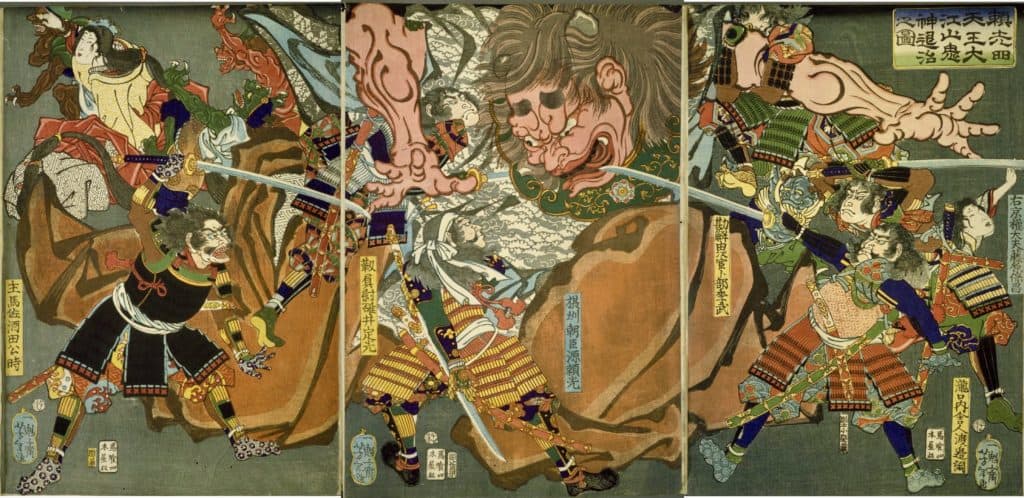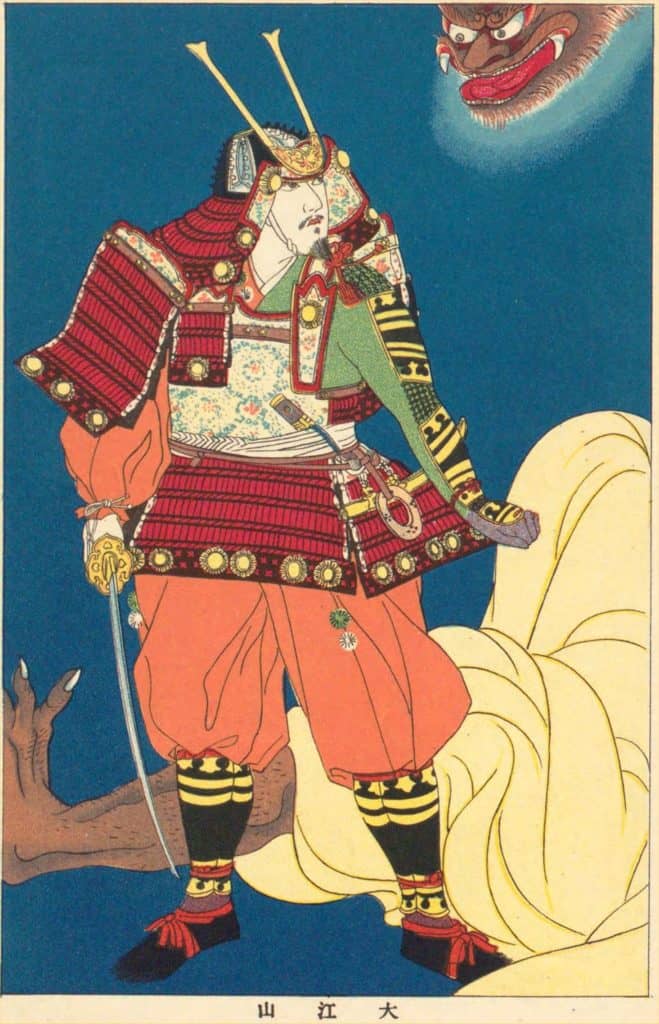
Oni are supernatural beings in Japanese folklore that can embody both benevolence and monstrosity. The name “oni,” often translated as “demon” or “ogre,” is believed to have originated from the word meaning “hidden.” Some oni are giant spirits who protect Shinto kami, deities, and bestow good fortune and wealth. These benevolent oni are sometimes depicted holding a wish-granting mallet. However, other oni are just the opposite, bringing harm and destruction.
Throughout Japanese history, inexplicable events were often attributed to the work of oni. Among the many stories of oni in Japan, the legend of Shuten-dōji is by far the most well-known. It has been rendered in countless works of traditional arts, including picture scrolls and ukiyo-e, jōruri storytelling, and noh, kabuki, and bunraku theater performances.
The Legend of Shuten-dōji
In the mountainous borderland of the former provinces of Tango and Tanba, which made up Kyoto Prefecture until the late 19th century, lived a band of oni. Their chief was called Shuten, meaning “Boozer,” due to his exceptional love of sake. His palace was hidden in a cave on Mount Oe.
During the reign of Emperor Ichijyō in the late 10th century, aristocratic maidens began to mysteriously disappear from the Japanese capital of Heian, now Kyoto City. The royal diviner, Abe no Seimei, used his mystical arts to determine that the culprit was Shuten-dōji, the strongest of all the oni, who resided on Mount Oe to the west.
To end this terror, the emperor called upon the valiant warriors Minamoto no Yorimitsu and Fujiwara no Hōshō, along with four of their most loyal retainers. These he sent to seek out Shuten-dōji and put an end to his horrendous crimes. Although renowned for their bravery, even they were apprehensive about the task ahead, for oni possess supernatural powers and can completely alter their appearances. The men knew they must remain vigilant to avoid being misled.
Traveling along the road to the mountain, the warriors visited four Shinto shrines to seek the help of the kami. As they pressed on, they encountered four yamabushi, ascetic mountain priests. The priests advised the warriors to disguise themselves and shared their extra robes.
Now garbed in priests’ clothing, Yorimitsu, Hōshō, and their retainers continued with their newfound allies. Soon, they reached a river where they met a ragged washerwoman. From her, they learned the path to Shuten’s palatial cave and the horrors endured by the kidnapped maidens. Once taken, the oni and his followers forced the young women into servitude, or when the fancy struck, sliced them open to eat their raw flesh and quaff their fresh blood.
As they spoke with the washerwoman, they realized she was the only daughter of a noble councilor who had disappeared months before. Incensed by her words, Yorimitsu and Hōshō were filled with renewed determination to avenge this assault upon the maidens of Heian.
The men approached Shuten-dōji’s impressive cave and told the oni guard that they were a band of lost yamabushi in need of lodging. Inside, Shuten-dōji questioned the men, as he had been warned by his spies in Kyoto that Minamoto no Yorimitsu and Fujiwara no Hōshō had been sent to vanquish him. However, their answers eased his suspicions, and Shuten-dōji invited the disguised warriors to his table.
As they sat together, eating unfamiliar flesh and sipping a foul beverage, the oni regaled them with stories from his past. Having spent many years on Mount Hie, he was banished when Saicho built Enryaku-ji Temple, so he made his new home in this spacious cave on Mount Oe. As he lifted his cup, he laughed that his name came from his insatiable thirst for sake.
One of the priests offered Shuten-dōji some of his sake, a gift, he said, from the Bodhisattva Hachiman. The oni eagerly drank it, and he quickly fell into an inebriated stupor and staggered off to his bedchamber.
After Shuten-dōji retired, a group of beautiful women arrived to entertain Yorimitsu and Hōshō, but the warriors were not deceived. Yorimitsu fixed a piercing stare upon the women, and as they fled, they transformed back into the oni they were. Next, a troupe of musicians came to play for them, and again, Yorimitsu’s fierce glare sent the masquerading oni running. It was now time to confront the chief himself, Shuten-dōji.
Yorimitsu, Hōshō, and their party approached Shuten-dōji’s bedchamber only to be stopped by a heavy and impenetrable iron door. The priests chanted incantations that dissolved the door, revealing the drunken Shuten-dōji lying upon his bed reverted to his true hideous form. He was over 15 meters (50 feet) tall, with a five-horned head, a red body, one white leg, one black leg, one yellow arm, and one blue.
While the four priests pinned down each of the huge oni’s limbs, Yorimitsu pulled out his sharp sword and with one powerful cut, severed Shuten-dōji’s head. As the giant was decapitated, he bellowed, “I’ve been betrayed! Kill these enemies!” His head flew through the air with his demonic mouth snapping at the noble Yorimitsu—but to no avail, as the wise warrior had not only donned his own helmet but also that of his comrade.

The men made quick work of the remaining oni and freed the surviving captives. Before departing, the yamabushi revealed their true identities. They were the same four deities to whom Yorimitsu and Hōshō had prayed at the shrines along their way to Mount Oe, having transfigured to human form to aid the warriors in answer to their prayers.
In triumph, Yorimitsu and Hōshō carried Shuten-dōji’s head to Kyoto, where they respectfully presented it to the emperor. After he and the fathers of the missing maidens had inspected the gruesome head, it was stored in the treasure house of Byodoin Temple in Uji, south of Kyoto City. Minamoto no Yorimitsu’s sword, which had dealt the fatal blow to the fearsome oni, earned its place as one of Japan’s Tenka Goken, Five Great Swords, and is a National Treasure.
If you have questions about Japan or suggestions for articles, please add them in the comments. For more photos and information on Japan, follow me on instagram at: https://www.instagram.com/more_than_tokyo/




